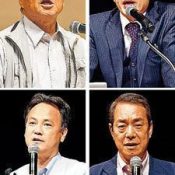
May 6, 2019 Ryukyu Shimpo
The East Asia Community Institute Okinawa (Ryukyu) held a public symposium titled, “Calling into question democracy in Japan – is Japan really an independent, democratic nation?” at the Ryukyu Shimpo Hall in Izumizaki, Naha May 5 (with support from Ryukyu Shimpo Co. Ltd.).
Kyoto Seika University Professor Satoshi Shirai headlined the speakers, and his lecture centered on the issues of the relocation of MCAS Futenma to the Henoko neighborhood in Nago as well as the Japan-U.S. Status of Forces Agreement (SOFA), stating among other things that Japan has failed to establish sovereignty in their relationship with the U.S. Around 400 people attended the lecture, listening with rapt attention.
Dr. Shirai indicated, “U.S. military bases are concentrated in Okinawa, in a system designed to hide the problem from mainland Japan.
The original reason for the bases, for ending the Korean War, is something the current powers-that-be have a distaste for.
Democracy on the mainland is becoming a shell of itself. Okinawa may be the only place in Japan where democracy is still functioning.”
Hiroji Yamashiro, head of the Okinawa Peace Movement Center, spoke about the 1947 “Emperor’s Message,” in which Emperor Hirohito expressed a hope that the United States would occupy Okinawa for an extended period of time, suggesting, “The message that sacrificed Okinawa continues to tie us down even to this day.
I wish I could ask the emperor to apologize to Okinawa and withdraw the message.
We need to raise our voices from here.” He then sang a song calling for people to participate in a protest in front of Henoko gate, exciting the crowd.”
Former Assistant Chief Cabinet Secretary Kyoji Yanagisawa said, “To ignore the will of the people in the name of national security is to have one’s priorities backwards.
The arguments of Okinawa’s geographically superiority and ability to deter aggression are no longer viable.
There are plenty of options beside military power.”
Okinawa International University Professor Hiromori Maedomari touched on the incident wherein a part from a U.S. military helicopter on Futenma Dai-ni Elementary School, commenting, “The Japanese government is unable to restrict the U.S. aircraft, forcing the children to run for cover.
Germany and Italy (both similarly defeated in World War 2) is enforcing their nation’s laws on the U.S. forces stationed there, and are moving to retake their national sovereignty.”
He proclaimed that Japan needs to solidify their sovereignty in relation to other countries.
Opening remarks were given by Okinawa governor Denny Tamaki.

Audience members listening intently to lecturers. May 5, Ryukyu Shimpo Hall in Izumizaki, Naha
Voices of solidarity from the audience as Yuzo Takayama and Lima Tokumori share their efforts to tell the world about the situation in Okinawa
Also at the symposium held by the East Asia Community Okinawa, Yuzo Takayama, who has a YouTube channel that features videos about the Henoko base issue, and Lima Tokumori, who campaigned in support of Denny Tamaki in last September’s gubernatorial election, both stepped up to the microphone to speak.
Takayama opposes the falsehoods and misinformation that swirls around the base issues in Okinawa, and continues his work providing easy to understand facts about these issues.
At the symposium, he reflected on the problems that have plagued MCAS Futenma since 1995.
“The voices of Okinawa have been completely trampled. Okinawa should be the ones to decide Okinawan matters. We must continue to raise our voices.”
Tokumori spoke about getting youth voters in their teens and 20’s to think about the future and get involved in last year’s gubernatorial election.
“I want to pass over the Japanese government and bring or message of peace from Okinawa. I want to engage people in other regions struggling with similar issues, and turn that angry energy into something positive.”
(English translation by T&CT and Sam Grieb)
Go To Japanese
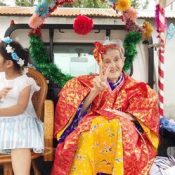
May 6, 2019 Ryukyu Shimpo
(Zamami) On April 28, a “kajimaya” celebration to celebrate 97 years of life and a “michi-june” parade were held in Zamami.
Ume Miyahira, age 96, of Zamami was the protagonist of the kajimaya celebration. She was born on March 14, 1923.
Miyahira rode from her home through the village in a brilliantly decorated open-top car with her relatives and neighbors.
Passersby who heard the music started dancing kachashi and shared in her celebration of long life.
Miyahira was born on Aka Island.
She moved to Zamami for marriage after the war at her parents’ advice.
At the time, Zamami Island was wartorn and she and her husband had no house, so they gathered logs from the valley and built their own house from the ground up.
There was no food, either, so the two of them rowed a sabani fishing boat to Aka Island to get food there.
On the day of the celebration, Miyahira’s family held a kajimaya celebration event at the Zamami Outlying Island Promotion Center.
The event was held with the support of the Zamami Village Office, the local youth group, and the Day Service Zamami Kaisei Center.
People from Okinawa Island and Aka Island and locals gathered to offer their congratulations and celebrate kajimaya with dance and song.

Participants do a kachashi dance to the music of sanshin at the “michi-june” parade in Zamami
“She broke a bone for the second time at the end of last year, but the strength she gained from experiencing the tumultuous period during and after the war helped her remain lively and not be set back by broken bones.
Her secret to maintaining vitality is talking a lot,” said Miyahira’s daughter, Junko Teruya, age 66.
Teruya says her mother now reflects on her youth and hopes that the people of the world will get along and not make war.
Miyahira spends her days at a day center for the elderly and enjoys her time there greatly.
It seems the secret to longevity is to enjoy life while also facing the past.
(English translation by T&CT and Sandi Aritza)
Go To Japanese
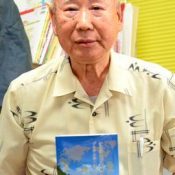
May 4, 2019 Ryukyu Shimpo
By Takaya Kinra
Isa, Ginowan City—Ansaburo Takushi, 76, emigrated to Brazil after the U.S. military seized his land, and later returned to Okinawa.
Takushi recently published an autobiography, titled “Ishihama Land Seizure and the Isahama Immigrants of Brazil.”
While the author often found himself at the mercy of the times, Takushi focused on his studies, and made a living for himself.
He looked back on his experience and said, “If you hold on tight and work hard, dreams will come true.”
He shares his story by giving away copies of his book to students in Okinawa of all ages, grade school through college.
Takushi was born in Isa, Ginowan City, in 1942.
The book incorporates photographs and his illustrations of the village layout, conveying the peaceful atmosphere of the time.
In 1955, during his first year in middle school, the U.S. military came with bayonets and bulldozers.
They seized land, which contained beautiful farm fields, and built Camp Zukeran (present-day Camp Foster).
Following the Ryukyu government’s recommendation, the local residents decided to emigrate to Brazil.
Takushi, who had begun his last year of middle school, moved to Brazil in 1957 with his parents.
He worked on a coffee farm as a day laborer, but wages were low.
Working conditions were so dreadful, his nose bled from the dust.
Takushi studied Portugese at the local school, and when he finally started adjusting to his new life, his home was burglarized. Furthermore, Brazil was experiencing a severe inflation at the time, and so his parents decided to return to Okinawa.
Out of the Isahama emigrants, the Takushis was the only family to return home.
He was hopeful when he left for Brazil, but returning to Okinawa in 1965 as a 23-year-old, he was anxious about starting a new life from scratch, and “couldn’t stop crying.”
There were embarrassing moments as well.
When Takushi took an entrance exam for a technical school alongside middle school students, a proctor, not realizing Takushi was an examinee, told him to “get out.”
Nonetheless, Takushi said he studied “as if my life depended on it,” and became a certified electrician, as he had aspired.
He worked while finishing school, and eventually set up an architectural design office, and a law firm.
Takushi said, “I want people to know that there are simple men like me out there, who have managed to navigate life.”
You can request a copy of his book by mail. Call Takushi at 098-898-5716 for inquiries.
(English translation by T&CT and Monica Shingaki)
Go To Japanese
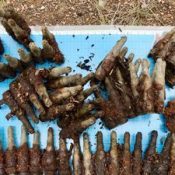
May 3, 2019 Ryukyu Shimpo
While Akino Miyagi was researching insects in Takae, Higashi Village in April this year, he found 71 unused U.S. blank cartridges on April 6 in the vicinity of what was the LZ-FBJ helipad on returned Northern Training Area (NTA) land in Kunigami Village.
Miyagi reported his discovery the same day.
The prefectural police collected the cartridges on May 2.
Aside from the cartridges, which measure 6.5 centimeters in length and 0.7 centimeters in diameter, Miyagi also found debris such as field ration bags.
Miyagi said, “Although the state of Marine Corps volunteer cleanup in Okinawa is clearly visible online, there is pollution in places citizens cannot see.
I am suspicious that environmental protection is only exercised in visible spots.”
(English translation by T&CT and Erin Jones)
Go To Japanese

May 2, 2019 Ryukyu Shimpo
Undistilled Awamori from the defunct Chiyoizumi Distillery in Miyako has once again entered the market, exciting those in the Awamori world.
As part of the “Liquor Pride Project” by Koji Higa, owner of Awamori Souko, an Awamori specialty bar in the Kume district of Naha, Awamori from the Chiyoizumi Distillery is once again being sold under the name “31/32.”
Higa says, “Through this project, I hope to share the profundity and greatness of Awamori with many people.”
For the Liquor Pride Project, 20,000 liter tanks of undistilled Awamori was purchased from the Chiyoizumi Distillery, which closed in March of 2018, and collaborated with another distillery to produce a new product for sale.
31/32 uses 100% undistilled Chiyoizumi Awamori, and reproduces the flavor of the original without additional processing.
The production year was not recorded so its age cannot be displayed, but the liquor is at least 10 years in age.
Only a small amount has been sold so far, however preparations have been made to ensure that it can be supplied reliably.
The name 31/32 has a dual meaning. The first refers to the numbers on the tanks that were purchased: 31 and 32.
The second meaning refers to the final day of operation for the Chiyoizumi Distillery, March 31, 2018.
According to Higa, “It gives a special extra day, the 32nd, to the Chiyoizumi Awamori, giving
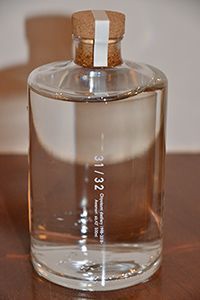
A bottle of 31/32 Awamori, made using undistilled Awamori from Chiyoizumi
it a new stage and the beginning to a new life.”
The bottle is designed to resemble the tanks in which it was stored, with a clear bottle and subtle, unobtrusive label.
Since the supply of the Awamori is limited, sale of the liquor will naturally end when it runs out.
A 500 ml bottle is selling for 12,980 yen (including tax).
Please contact Awamori Souko (Tel. 098 (869) 0808).
(English translation by T&CT and Sam Grieb)
Go To Japanese
May 3, 2019 Ryukyu Shimpo
On May 2 the U.S. military conducted parachute drop training over the ocean at Tsukenjima Training Area in Uruma City.
In the exercise, nine people in total dropped out of an MC-130 special mission aircraft.
This is the second such training conducted this year.
Individuals involved in the fishing industry have openly opposed the training.
Liners and fishing boats traverse the water training area.
The Okinawa Prefectural Government (OPG) and Uruma City government are requesting that these training exercises stop.
Five people practiced parachute drop training just past 1:00 p.m., and four more followed suit around 1:30 p.m., falling into the water.
The U.S Federal Aviation Administration (FAA) announced that training would be conducted between 1:00 and 5:00 p.m. in a Notice to Airmen (NOTAM).
Mozuku seaweed in the vicinity of the water training area has reached its peak season.
During Golden Week people visit to go diving.
Yonashiro Town Fishery Cooperative president Masayuki Tamae said, “Worst-case, there could be an accident and oil could spill [into the ocean].
I want training in the beautiful ocean to stop.”
(English translation by T&CT and Erin Jones)
Go To Japanese
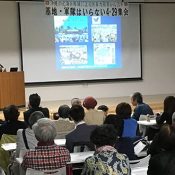
April 30, 2019 Ryukyu Shimpo
On April 29 a rally met at the Bunkyo Civic Center in Tokyo to protest the presence of the U.S. bases and military personnel in Okinawa.
The rally was held in observation of the third anniversary of the rape and murder committed by a former U.S. Marine.
More than 200 people attended.
Suzuyo Takazato, a representative of Okinawa Women Act Against Military Violence, spoke about recurring incidents of sexual violence by U.S. military personnel throughout the postwar period.
She said, “The privileges granted in the U.S.-Japan Status of Forces Agreement (SOFA) links to violence against women,” arguing that it is essential to revise the SOFA.
Takazato also referred to the base burden reduction policy that emerged after the rape of an Okinawan schoolgirl in 1995, saying, “[The policy] was a showpiece brought out to quell the anger and demands of Okinawans, but what are the results?
Also, military functions have been enhanced and installations have made advancements, and the ’95 incident has led to [the current circumstances in] Henoko.”
In regard to Futenma Replacement Facility construction being forced through in Henoko, Takazato pointed out that construction is supported, in part, due to discriminatory beliefs throughout Japan.
After the recent murder of a woman in Chatan Town, Takazato lamented, “Three years ago we decided to never allow such a thing to happen again, yet it has happened.”
One of the rally organizers, Mieko Hokama of the Okinawa One-tsubo Anti-War Landowners Association Kanto Block, spoke about Japan’s reaction to the new Emperor taking over.
Hokama said, “Japan’s current brouhaha is unpleasant to the point of being nauseating.
The Emperor of Japan handed Okinawa over to the United States. It is as though time has stopped for the Uchinanchu.”
(English translation by T&CT and Erin Jones)
Go To Japanese
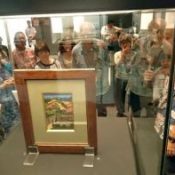
May 1, 2019 Ryukyu Shimpo
On April 30, the Okinawa Prefectural Museum & Art Museum started their “New Collection Exhibition.”
The exhibition displays about 250 items that were donated or bought in the last year.
The items include human bones of the Minatogawa people, former Governor Masahide Ota’s handwritten manuscripts, and painter Seikan Omine’s painting “Okinawa Fuukei (Okinawa Scenery).”
The exhibition will last until June 23.
The three human bones of the Minatogawa people were discovered and preserved by late Seiho Oyama’s eldest son, Seiko Oyama, age 82.
It is believed that the lower jaw bone, which is one of the three bones, belonged to an individual other than the four skeletons that are kept at the museum.
Oyama said, “I hope that many Okinawan citizens can learn about and become interested in precious human bones being found in Okinawa via the exhibition.”
Former Governor Ota’s documents include 75 items. The items include manuscripts dated from 1967’s edition of “The Consciousness of the Common People of Okinawa” to manuscripts written in October 2016 before his death.
Omine’s artwork “Okinawa Fuukei (Okinawa Scenery)” was a landscape painting that was bestowed from Naha Mayor Junji Nishime (at the time) to High Commissioner Paul Caraway.
During the opening ceremony, Museum Director Masayuki Dana greeted everyone saying, “These documents are valuable. Through research and study, we hope to find a way to make good use of these so they can be appreciated by Okinawan citizens.”
(English translation by T&CT and Chelsea Ashimine)
Go To Japanese
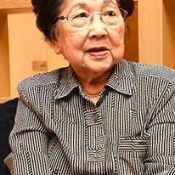
April 28, 2019 Ryukyu Shimpo
By Yoshinori Takada
On April 30, the emperor will abdicate, marking the end of the Heisei era. The emperor has visited Okinawa eleven times from the time he was crown prince to the present. Both the emperor and empress have visited Okinawa, the only place in Japan to experience a land battle during the war and where a huge number of civilians suffered in the battle, to pay their respects to the lives lost. Some hold the Showa emperor responsible for the war; meanwhile, the Heisei emperor has endeavored to be a friend to Okinawa. As we approach the start of the Reiwa era, survivors of the war have distinct feelings towards the emperor system and the imperial family.
– Former Shiraume Student Nurse Corps member Kiku Nakayama says her resentment has melted away
The emperor and empress slowly rose from their seats. They turned partway around and bowed their heads deeply. They were facing in the direction of the Shiraume Memorial Tower.
In November 2012, the emperor and empress were in Okinawa for the 32nd Nationwide Event for Creating Bountiful Oceans. Kiku Nakayama, 90, of Naha, who was mobilized during the Battle of Okinawa as a member of the Shiraume Student Nurse Corps from the Okinawa Prefectural Daini Girls High School, met with the emperor and empress at the Okinawa Peace Hall in Itoman.
Nakayama sat across a table from the emperor and empress in a small room. She says she explained to them how there were nine female student corps in Okinawa, and how she speaks about her experience so that war will never be repeated; they responded with deep nods and comments of, “What a harrowing experience,” and, “That is very important.”
Once the allotted ten minutes were up, Empress Michiko asked the direction of the Shiraume Memorial Tower. Nakayama told her the direction, and both emperor and empress rose from their seats.
Nakayama was born on the enthronement day the Showa emperor, and was given the name Kiku, written with the Chinese character meaning chrysanthemum–a symbol of the imperial throne. She despised her father, whose illness prevented him from joining the military, and joined the student corps of her own accord. Nonetheless, after the war she was unable to shed the sense that Okinawa was sacrificed in order to protect the emperor system. That was why, when she got a new household register to replace the one that was lost in fire, instead of using the character for chrysanthemum to write her name, she wrote it as “Kiku” in the hiragana syllabary.
The emperor visited Okinawa 11 times. “When I met him, I understood that he really has a place in his heart for Okinawa. My resentment melted away,” Nakayama recalls.
– Keiko Taira, survivor of the Tsushima-maru sinking, recalls the faces of the children who died
Some people still feel negatively about the imperial household. Keiko Taira, 84, of Ogimi, is a survivor of the Tsushima-maru, a ship carrying student evacuees that was sunk during the war. In June 2014, 70 years after the Tsushima-maru was sunk by a torpedo from a U.S. naval submarine in August 1944, the emperor and empress visited the Tsushima-maru Memorial Museum in Naha. Taira was notified of their visit in advance by museum staffers, but she chose not to meet them.
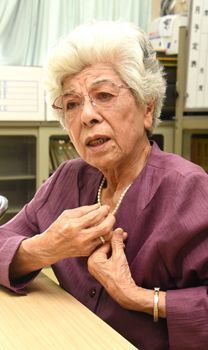
Keiko Taira says that when she thinks of the children who perished, she is unable to accept the emperor system; on April 26, in Ogimi
Roughly 1,500 children died on the ship. “The boys dreamed of becoming kamikaze pilots or soldiers to protect the emperor. The girls dreamed of becoming nurses for the troops,” Taira says. The children were taught to devote themselves to their country and to the emperor. Taira’s memories of the national elementary school involve more evacuation drills and martial arts training than schoolwork. At the school gate when arriving and leaving the school, and in the classroom, the students were made to perform a deep bow of obeisance many times a day. Eight seconds to put their heads down, and eight seconds to raise them back up.
After making it out of the sinking alive, Taira also experienced the Battle of Okinawa. She feels not that her life was spared, but that she pulled through. “The fighting was constant,” she says. “At sea and after I came back to Okinawa, it was impossible to survive without sacrificing someone else’s life.” The faces of the children who lived and died for the emperor arose in her mind, and she decided not to meet the emperor.
Taira knows that the emperor paid his respects at war sites and disaster-stricken areas. “I don’t dislike the emperor as a person. But it was because of the emperor system that Japan plowed into the war. I don’t regret not going to meet the emperor,” she says with a piercing look.
(English translation by T&CT and Sandi Aritza)
Go To Japanese

April 28, 2019 Rykyu Shimpo
By Tamiko Suzuki
The Okinawa Prefectural Government and the George Washington University Okinawa Collection held an awards ceremony at the university’s Gelman Library in D.C. on March 19 to recognize the Okinawa Essay Contest winners.
The contest invited undergraduate and graduate students from the District of Columbia, Maryland, Virginia, and Hawaii to submit academic research essays on Okinawa, of which three winning essays were selected. Each winner presented their essay at the awards ceremony.
First place was awarded to Hilson Reidpath, a doctorate student at the University of Hawai’i, whose essay examined Okinawan poet Baku Yamanokuchi’s identity struggle through the poet’s work.
The essay also points out stereotyping and discrimination of Okinawans by mainland Japanese.
Second place went to Christine Mari Inzer, a graduate of the University of Richmond.
Her essay, “Contesting Japanese Post-War Memory in Modern Okinawan Literature,” presents the view that postwar Okinawa still remains oppressed, through the works of Okinawan writers including Tatsuhiro Ōshiro.
Third place was awarded to Nina Udagawa from George Washington University, who investigated the circumstances Amerasians encountered in Okinawa.
The essay researched the process of overcoming identity crises and finding self-affirmation.
The three winners were awarded cash prizes, and will be invited to travel to Okinawa this summer.
Okinawa Prefectural Government Washington D.C. Office Chief Osamu Unten said, “The contest aims to raise awareness of Okinawa’s various issues through research on Okinawan culture, economics, history, politics and society.
We hope to facilitate discussions between the young generation of Okinawa and the U.S., to deepen appreciation of each other and build a good relationship.”
(English translation by T&CT and Monica Shingaki)
Go To Japanese














 Webcam(Kokusai Street)
Webcam(Kokusai Street)


